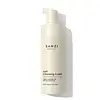What's inside
What's inside
 Key Ingredients
Key Ingredients

No key ingredients
 Benefits
Benefits

 Concerns
Concerns

No concerns
 Ingredients Side-by-side
Ingredients Side-by-side

Aloe Barbadensis Leaf Water
MaskingWater
Skin ConditioningCucumis Sativus Fruit Water
Skin ConditioningGlycerin
HumectantDisodium Laureth Sulfosuccinate
CleansingAcrylates Copolymer
Sodium Coco-Sulfate
CleansingLauryl Glucoside
CleansingSodium Cocoyl Glutamate
CleansingCaprylyl/Capryl Glucoside
CleansingXanthan Gum
EmulsifyingC12-15 Pareth-12
EmulsifyingSodium Benzoate
MaskingPotassium Sorbate
PreservativeCaprylyl Glycol
EmollientCitric Acid
BufferingPhenoxyethanol
PreservativeAlcohol
AntimicrobialSodium Hydroxide
BufferingAloe Barbadensis Leaf Water, Water, Cucumis Sativus Fruit Water, Glycerin, Disodium Laureth Sulfosuccinate, Acrylates Copolymer, Sodium Coco-Sulfate, Lauryl Glucoside, Sodium Cocoyl Glutamate, Caprylyl/Capryl Glucoside, Xanthan Gum, C12-15 Pareth-12, Sodium Benzoate, Potassium Sorbate, Caprylyl Glycol, Citric Acid, Phenoxyethanol, Alcohol, Sodium Hydroxide
Water
Skin ConditioningSodium Cocoyl Glutamate
CleansingButylene Glycol
HumectantGlycerin
Humectant3-O-Ethyl Ascorbic Acid
Skin ConditioningEuterpe Oleracea Fruit Extract
Cucurbita Pepo Seed Extract
Skin ConditioningEchinacea Purpurea Extract
MoisturisingSodium PCA
HumectantAloe Barbadensis Leaf Extract
EmollientCentella Asiatica Extract
CleansingChrysanthellum Indicum Extract
Skin ConditioningOpunta Dillenii Extract
Ethylhexylglycerin
Skin ConditioningPhenoxyethanol
PreservativeWater, Sodium Cocoyl Glutamate, Butylene Glycol, Glycerin, 3-O-Ethyl Ascorbic Acid, Euterpe Oleracea Fruit Extract, Cucurbita Pepo Seed Extract, Echinacea Purpurea Extract, Sodium PCA, Aloe Barbadensis Leaf Extract, Centella Asiatica Extract, Chrysanthellum Indicum Extract, Opunta Dillenii Extract, Ethylhexylglycerin, Phenoxyethanol
 Reviews
Reviews

Ingredients Explained
These ingredients are found in both products.
Ingredients higher up in an ingredient list are typically present in a larger amount.
Glycerin is already naturally found in your skin. It helps moisturize and protect your skin.
A study from 2016 found glycerin to be more effective as a humectant than AHAs and hyaluronic acid.
As a humectant, it helps the skin stay hydrated by pulling moisture to your skin. The low molecular weight of glycerin allows it to pull moisture into the deeper layers of your skin.
Hydrated skin improves your skin barrier; Your skin barrier helps protect against irritants and bacteria.
Glycerin has also been found to have antimicrobial and antiviral properties. Due to these properties, glycerin is often used in wound and burn treatments.
In cosmetics, glycerin is usually derived from plants such as soybean or palm. However, it can also be sourced from animals, such as tallow or animal fat.
This ingredient is organic, colorless, odorless, and non-toxic.
Glycerin is the name for this ingredient in American English. British English uses Glycerol/Glycerine.
Learn more about GlycerinPhenoxyethanol is a preservative that has germicide, antimicrobial, and aromatic properties. Studies show that phenoxyethanol can prevent microbial growth. By itself, it has a scent that is similar to that of a rose.
It's often used in formulations along with Caprylyl Glycol to preserve the shelf life of products.
Sodium Cocoyl Glutamate is a gentle cleanser and surfactant. It is the sodium salt of the Cocoyl Glutamic Acid and comes from coconut oil. As a surfactant, it helps lift dirt and oil to be washed away.
Sodium Cocoyl Glutamate also has an emolliating effect and can help leave the skin feeling soft.
Water. It's the most common cosmetic ingredient of all. You'll usually see it at the top of ingredient lists, meaning that it makes up the largest part of the product.
So why is it so popular? Water most often acts as a solvent - this means that it helps dissolve other ingredients into the formulation.
You'll also recognize water as that liquid we all need to stay alive. If you see this, drink a glass of water. Stay hydrated!
Learn more about Water